Although no total lunar eclipses occur this year, skywatchers can look forward to two “central” solar eclipses — including an annular event in October whose path runs from Oregon through Texas.

Eliot M. Herman
Up to seven eclipses of the Sun and Moon can take place in one year, though the last time that happened was 1982, and the fewest possible is four.
That latter, minimalist mix is what’s in store for 2023, and it’s an odd assortment as well. There’ll be a “hybrid” (total/annular) solar eclipse in April and an annular solar eclipse in October — the latter seen well from North America — but 2023’s two lunar eclipses will be barely noticeable.
Why Do Eclipses Happen?
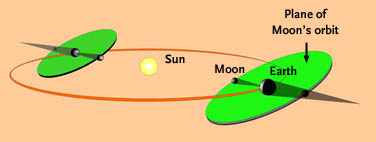
Jay Anderson
Before describing this year’s individual events, let’s explore some eclipse basics.
A solar eclipse, such as the one seen coast to coast across the U.S. in August 2017, occurs only at new Moon, when the lunar disk passes directly between us and the Sun and consequently the Moon’s shadow falls somewhere on Earth’s surface.
Conversely, a lunar eclipse takes place during full Moon, when our satellite passes through Earth’s shadow.
These alignments don’t happen at every new and full Moon because the lunar orbit is tipped about 5° to Earth’s orbital plane — only occasionally do the Sun, Earth, and Moon line up exactly enough for an eclipse to occur. (The technical name for that, by the way, is syzygy.) And, as the diagram above implies, those alignments occur roughly a half year apart. So since the last eclipse of 2022 occurred in early November, the first eclipse of 2023 doesn’t take place until April 20th.
Lunar Eclipses
Three types of lunar eclipse are possible (total, partial, and penumbral), depending on how deeply the full Moon plunges into or near the umbra, our planet’s dark, central shadow.
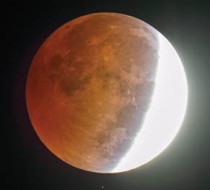
Johnny Horne
If the Moon goes all the way in, we see a total lunar eclipse that’s preceded and followed by partial phases. That was the case during the widely viewed event in September 2015, which marked the conclusion of a series of four consecutive total lunar eclipses! Such eclipse tetrads are not common — the last one occurred during 2003–04, but the next won’t begin until 2032.
If the Moon ventures just partly into the umbra, as pictured here, only the partial phases occur — you’ll see some of the Moon in nearly full sunlight, and some of it steeped in the deep, red-tinged umbral shadow.
And if its disk passes just outside the umbra, the Moon still encounters the weak penumbral shadow cast by Earth. A sharp-eyed observer will notice that one side of the full Moon’s disk looks a little dusky. All four of 2020’s lunar eclipses were of the penumbral variety.
Fortunately, every lunar eclipse is observable anywhere on Earth where the Moon is above the horizon. (But there’s still an element of luck involved — after all, the sky has to be clear!)
Solar Eclipses
Annular and total solar eclipses require the Moon to cross directly in front of the Sun as seen from Earth — and, as the graphic below shows, such “central” solar eclipses can only occur within a two-week-long interval when the Moon crosses the ecliptic during one of its two nodal crossings each year. However, the geometric window for partial solar eclipses is wider, roughly five weeks long.

Jay Anderson
If the Moon completely hides the Sun, the eclipse is considered total. With its brilliant disk completely covered, the Sun’s ghostly white outer atmosphere, called the corona, is momentarily revealed for durations from seconds to several minutes.
Occasionally the Moon passes directly in front of the Sun but doesn’t completely cover it. When that occurs, it’s usually because the Moon is farther from Earth than its average distance. (The Moon’s orbit isn’t perfectly circular; its eccentricity is about 5%.) This geometric circumstance is known as an annular eclipse, so-called because you can see a ring, or annulus, of sunlight surrounding the lunar disk. Annular eclipses of the Sun occur about as often as the total ones do.
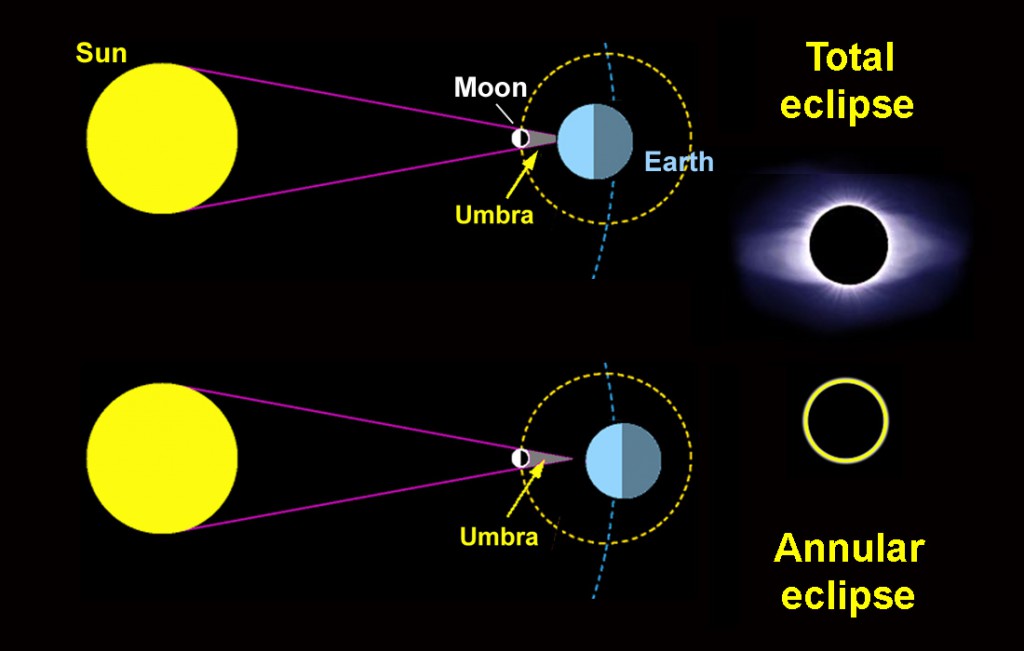
Sky & Telescope
Unlike total lunar eclipses, which can be viewed from roughly half of Earth’s surface, total and annular solar eclipses tightly restrict where you can see them because the Moon casts a smaller umbral shadow than Earth does — and you need to be within that shadow to view the event. A completely eclipsed Sun can be viewed only from a narrow track or path on Earth’s surface that’s typically just 100 miles (160 km) wide. Outside of that path, about half of the daylit hemisphere of Earth is able to watch a partial solar eclipse as the Moon obscures a portion of the Sun.
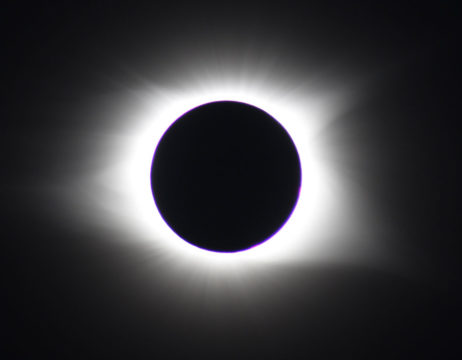
Sky & Telescope / J. Kelly Beatty
Getting to the path of a total or annular eclipse often involves long-distance travel. In November 2013, for example, planeloads of eclipse-chasers thronged to a remote corner of northern Kenya to watch just 11 seconds of totality. On December 4, 2021, some 15 cruise ships converged on the eclipse path in a remote stretch of the Southern Ocean hundreds of miles northeast of the Antarctic Peninsula. Yet only one of those ships succeeded in dodging the early morning clouds and glimpsing totality. What dedication!
Every location on Earth experiences a total solar eclipse every 375 years on average, with the Northern Hemisphere enjoying a slight statistical advantage right now. (To explore the worldwide distribution of total eclipses more closely, check out Sky & Telescope’s beautiful eclipse globe.)
The Four Eclipses of 2023
Below are brief descriptions of the four eclipses that take place in 2023. You’ll find more details in Sky & Telescope magazine or on this website as the date of each draws near. Times are given in Universal Time (UT) except as noted. Adjust these to get those for your time zone: for example, PST = UT – 8, and EST = UT – 5. (But be sure to allow for daylight or “summer” time: PDT = UT – 7, and EDT = UT – 4.)
| Date | Type | Maximum | Visibility |
| April 20 | Hybrid solar eclipse | 4:17 UT | southeast Asia, Australia |
| May 5 | Penumbral lunar eclipse | 17:23 UT | central and eastern Asia, Australia |
| October 14 | Annular solar eclipse | 18:00 UT | North, Central, and South America |
| October 28 | Partial lunar eclipse | 20:14 UT | Europe, Africa, Asia, w. Australia |
April 20: Hybrid Solar Eclipse
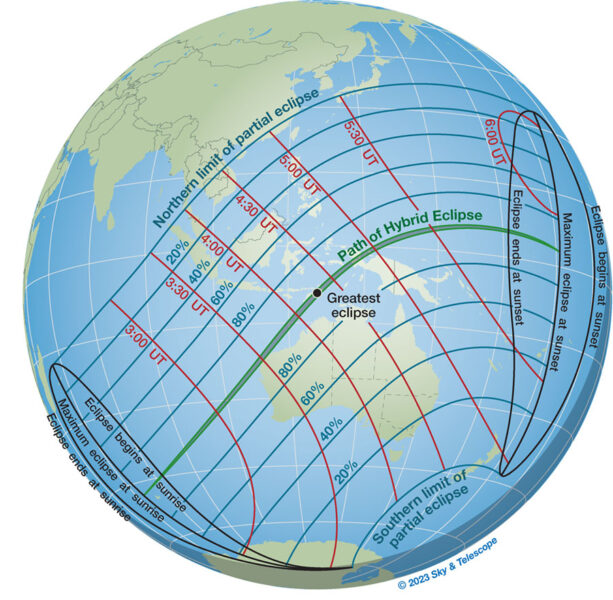
The year’s first event is a geometric oddity: a hybrid solar eclipse, one that is total in the middle but annular at its beginning and end. This occurs because mid-eclipse occurs at a point on Earth that’s closer to the Moon by roughly Earth’s radius (about 4,000 miles). From that spot, the Moon appears slightly larger than it does from locations at the beginning and end of the eclipse track. So the Sun’s disk can appear completely covered when viewed at the middle of the track but appear as a thin or broken ring at either end of it. This unusual geometry also means that totality doesn’t last long, a maximum of only 76 seconds in this case, and the path is at most only 30 miles wide.
Hybrid (or “annular/total”) solar eclipses occur only about once per decade; the previous one was in November 2013, and the next will take place in November 2031.
The track for April’s hybrid eclipse starts in the southern Indian Ocean, barely clips the westernmost corner of Australia, and crosses Timor-Leste and southern Indonesia before sliding off into the Pacific Ocean. However, such remoteness has not deterred the thousands of avid “umbraphiles” who will cram onto Australia’s Exmouth Peninsula or chase down the Moon’s shadow aboard cruise ships off the Australian coast. The prospects for clear weather there are quite favorable.
May 5: Penumbral Lunar Eclipse
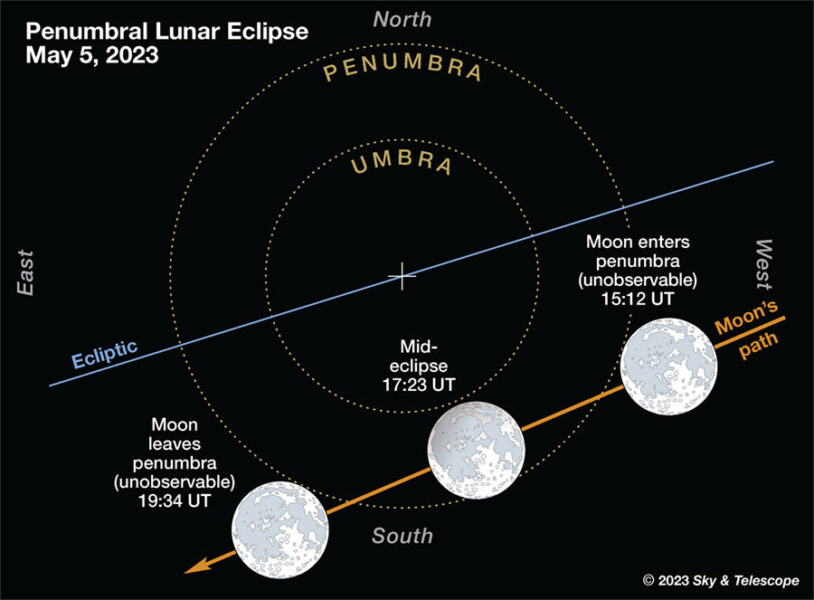
Two weeks after April 20th’s solar eclipse, after the Moon has moved to the opposite side of its orbit and becomes full, it grazes the northern edge of Earth’s shadow during a penumbral lunar eclipse. This is a particularly deep incursion into the penumbra, and in fact the Moon just misses dipping into the much darker umbra. So an attentive observer should notice that the northern half of the lunar disk looks a little dusky. However, to see this “barely there” eclipse, you’ll need to be in Europe, Africa, Asia, or Australia. It’s a daylight event — and thus unobservable — in North and South America.
October 14: Annular Solar Eclipse
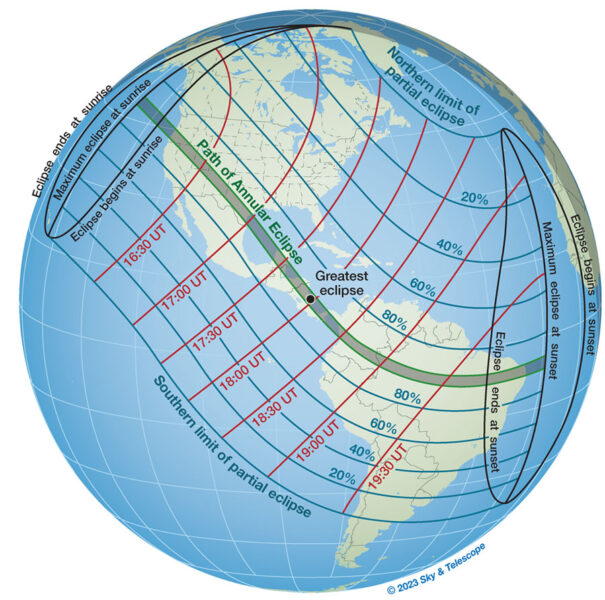
October’s annular solar eclipse can be witnessed in the United States along a broad swath from Orgeon through Texas. After that, the Moon’s shadow crosses the Yucatán Peninsula, Central America, Colombia, and Brazil. Annularity lasts its longest , 5m 17s, just off the coast of the Nicaragua-Costa Rica border. A portion of Hill Country in Texas, just northwest of San Antonio, falls within the paths both for this eclipse and for the total solar eclipse that crosses North America just six months later.

eclipsophile.com
Here’s a list of local circumstances for 10 locations in North America that will witness an annular solar eclipse, given in local time (24-hour format):
| City | Eclipse begins | Annular begins | Annular ends | Eclipse ends | Annular duration |
| Eugene, Oregon | 8:05 | 9:17 | 9:21 | 10:40 | 3m48s |
| Medford, Oregon | 8:05 | 9:18 | 9:19 | 10:40 | 1m3s |
| Elko, Nevada | 8:07 | 9:22 | 9:27 | 10:50 | 4m18s |
| Bryce, Utah | 9:09 | 10:28 | 10:31 | 11:58 | 2m53s |
| Farmington, New Mexico | 9:12 | 10:32 | 10:36 | 12:05 | 4m19s |
| Albuquerque, New Mexico | 9:13 | 10:34 | 10:39 | 12:09 | 4m50s |
| Midland, Texas | 10:18 | 11:43 | 11:48 | 13:22 | 4m55s |
| San Antonio, Texas | 10:24 | 11:52 | 11:56 | 13:33 | 4m24s |
| Corpus Christi, Texas | 10:26 | 11:56 | 12:01 | 13:38 | 5m2s |
| Campeche, Mexico | 10:46 | 12:22 | 12:27 | 14:09 | 4m23s |
A partial solar eclipse can be observed that day from virtually everywhere in North and South America. Here’s a list of local circumstances for 12 major cities that will witness a partial coverup, given in local time and 24-hour format; in the table, obscuration (Obs.) is the fraction of the Sun’s area and magnitude (Mag.) the fraction of the Sun’s diameter that’s blocked by the Moon at eclipse maximum:
| City | Begins | Maximum | Ends | Obs. | Mag. |
| Seattle, Washington | 8:08 | 9:20 | 10:40 | 80% | 86% |
| San Francisco, California | 8:05 | 9:20 | 10:42 | 76% | 83% |
| Las Vegas, Nevada | 8:08 | 9:27 | 10:54 | 82% | 87% |
| Denver, Colorado | 9:14 | 10:36 | 12:06 | 79% | 85% |
| Phoenix, Arizona | 8:11 | 9:32 | 11:02 | 79% | 85% |
| Dallas, Texas | 10:24 | 11:53 | 13:30 | 81% | 86% |
| Chicago, Illinois | 10:37 | 11:58 | 13:23 | 43% | 54% |
| New York, New York | 12:09 | 13:22 | 14:36 | 23% | 35% |
| Atlanta, Georgia | 11:43 | 13:12 | 14:45 | 52% | 62% |
| Miami, Florida | 11:57 | 13:34 | 15:12 | 58% | 67% |
| Mexico City, Mexico | 10:37 | 12:10 | 13:51 | 70% | 77% |
| Buenos Aires, Argentina | 16:03 | 16:44 | 17:22 | 6% | 13% |
Eclipse specialist Fred Espenak, who supplied the tables above, has computed local circumstances for hundreds of cities and also has an interactive map that provides them for any location.
October 28: Partial Lunar Eclipse
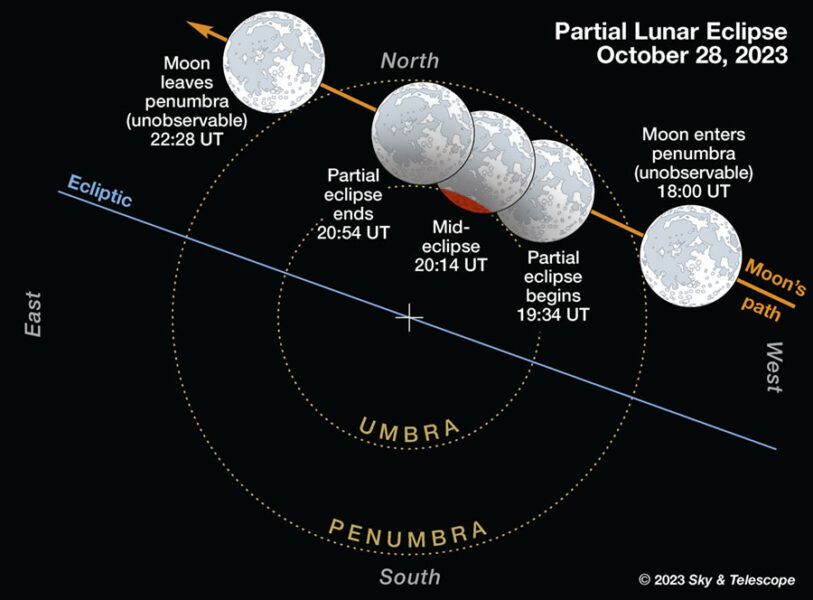
The year’s second lunar eclipse comes two weeks after October 14th’s solar eclipse. The partial phase is brief, lasting just 80 minutes — and at the event’s maximum (20:14 Universal Time), only 13% of the Moon’s diameter will intrude into Earth’s dark umbra. At mid-eclipse, you’ll see a full Moon with dusky southern limb and a small slice missing from its bottom — if you happen to be in Europe, Africa, most of Asia, and western Australia. (It’s not visible from the Western Hemisphere.) And, in case you’re wondering, the next total lunar eclipse won’t occur until March 14, 2025.)
Looking Ahead to 2024
Next year the minimalist trend continues, with just four eclipses in the offing. Once again, the Moon can only muster a penumbral eclipse on March 25th and a “just barely” partial eclipse on September 18th — though both of these are observable from the U.S.
And, once again, the Sun-Moon-Earth alignments produce one total and one annular solar eclipse. The first of these, on April 8th, is eagerly awaited across North America — the path of totality crosses central Mexico, the United States from Texas to New England, and Canada’s Maritime Provinces. Even better, totality will last up to 4m 28s.
Although the path of the annular eclipse on October 2nd crosses the southern tip of South America and thus would seem challengingly remote to reach, it has the novel appeal of passing directly over Rapa Nui (a.k.a. Easter Island)!
| Sky & Telescope offers great opportunities to view the solar eclipses in 2023 and 2024. You can explore the celestial prowess and dazzling art and architecture of the ancient Maya — and witness October 2023’s annular solar eclipse — on our 10-day tour of the Yucatán Peninsula. For the total eclipse in April 2024, you’ll have two options: Watch from a choice location in the Hill Country of Texas (where bluebonnets will be in full springtime bloom) or on a two-week cruise along the “Mexican Riviera” with eclipse viewing just off the coast of Mazatlán. And don’t miss the chance to witness more than 6 minutes of annularity while standing amid the imposing moai of Easter Island. |
 2
2
Comments
Anthony Barreiro
January 9, 2023 at 6:28 pm
Thank you very much. I'm looking forward to observing the October 2023 solar eclipse (partial here in San Francisco) and the April 2024 total solar eclipse -- worth traveling to see!
One small correction: The text for the May 5 lunar eclipse states, "Two weeks after April 20th’s solar eclipse, after the Moon has moved to the opposite side of its orbit and becomes full, it grazes the northern edge of Earth’s shadow during a penumbral lunar eclipse." The Moon, 19 hours past her descending node, will pass close to the *southern* edge of the Earth's shadow.
You must be logged in to post a comment.
Tom Kellogg
January 13, 2023 at 12:23 am
Thanks Anthony. I, too, am looking forward to the partial solar eclipse from Santa Cruz Oct. 14, 2023 and am not sure where I will travel for the 4/8/24 total solar eclipse.
You must be logged in to post a comment.
You must be logged in to post a comment.